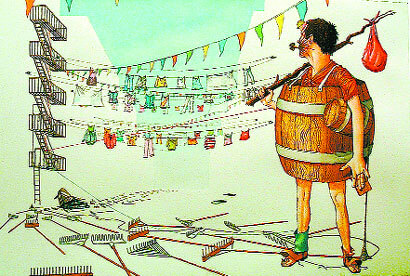Heimbinder’s large-scale drawings and watercolors enjoy life’s dark quirkiness
Throughout the past century, pictorial and linear narrative has been turned on its head. In the aftermath of two world wars and as the planet shivered through the nuclear standoff of the Cold War, such narratives were no longer regarded as conducive to reinforcing a critical socio-political mythology—that of reassurance. Advertising picked up the slack, taking up as a central mission the task of encouraging a culture of desire based on consumption.
The responsibility of forming a transcending narrative form fell into the hands of artists like George Grosz, Salvador Dali, Ben Shahn, Phillip Guston, and more recently the Chapmans, Dinos and Jake, and Robert R. Crumb. These artists and many more have created a potent and dislocated narrative, at times contemplative or combative and often filled with uncertainty accurately representing the world which they witnessed. It is this lineage that Daniel Heimbinder’s work appears to build upon in his second solo exhibition at Clementine Gallery.
The gallery is host to several of Heimbinder’s large-scale ink and watercolor works on paper. Each one is a window into a bizarre, psychosexual, and violent drama that draws you into the anxiety of the unfolding story. “Blue Yodel #13,” accurately subtitled “Insult as Injury,” is perhaps the most compelling image with its use of a striking single male figure. He stands in the foreground of a clothesline-bedecked city street, comically clothed in only a barrel with the remnants of an exploded cigar in his mouth, a hobo’s sack on a stick slung over his shoulder, beset by impending disaster. From the matches wedged between his toes ripe for a hotfoot to the scattered rakes waiting for a slapstick moment, the protagonist of this tale is in mid-step towards mishap.
That sort of anxious comic relief successfully sustains much of the work in this show. Heimbinder’s emotive versatility can be unsettling at times in works such as “Charm Bracelet,” which depicts a saccharine parade of reindeer with needles instead of hooves trampling over the anthropomorphic arm attached to a figure reminiscent of a Dali painting or a Monty Python cartoon.
Heimbinder’s skill is clear. He has a strong sense of line and color and is adept at using it to render the world as he bears witness to its absurdities with a dark comic sensibility that gives pause in this culture of want and distraction.



































